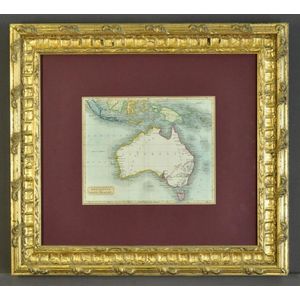Art Nouveau Porcelain Plaque of Nude Dancer by Gotz
An Art Nouveau, Pate-sur-pate, Limoges porcelain plaque, early 20th century. By Gotz of Limoges, inscribed 'D'apres Baron'. Depicting a nude dancer 16 x 13 cm-plaque size 31 x 28 cm frame
You must be a subscriber, and be logged in to view price and dealer details.
Subscribe Now to view actual auction price for this item
When you subscribe, you have the option of setting the currency in which to display prices to $Au, $US, $NZ or Stg.
This item has been sold, and the description, image and price are for reference purposes only.
- Pâte-Sur-Pâte - Pâte-sur-pâte is a decorative technique that is commonly used in ceramics and glassmaking. The term "pâte-sur-pâte" is French and it translates to "paste on paste." This technique involves the application of layers of clay or glass paste to create a three-dimensional design.
In ceramics, the technique involves applying successive layers of a clay slip onto a piece of pottery. Each layer is allowed to dry before the next one is applied. The layers are then carved or incised to create a design in relief. This technique is often used to create delicate and intricate designs, such as figures or floral motifs.
In glassmaking, the technique involves applying layers of molten glass onto a blown glass form. The layers are then carved or etched to create a design in relief. This technique is often used to create intricate designs, such as floral motifs or animals.
Both techniques require a high level of skill and precision, as the layers must be applied and carved with great care to achieve the desired effect. The end result is a beautiful and unique piece of art that showcases the artist's talent and mastery of their craft. - Art Nouveau Period - The Art Nouveau period was a cultural movement that emerged in the late 19th century, and was characterized by its emphasis on natural forms, flowing lines, and a decorative, ornamental style. Art Nouveau was a reaction against the ornate and heavily stylized designs of the previous era, and sought to create a new, more organic aesthetic.
Art Nouveau was characterized by its use of sinuous, curving lines, as well as a focus on natural elements such as flowers, vines, and other organic shapes. Art Nouveau designers sought to create a total work of art, in which every element of a building or object was designed to be harmonious with the overall design.
Some of the most iconic examples of Art Nouveau design include the Paris Metro entrances designed by Hector Guimard, the works of the artist Alphonse Mucha, and the architecture of Victor Horta in Brussels.
The Art Nouveau period was at its peak between 1890 and 1910, but began to decline in popularity by the start of World War I. However, Art Nouveau remains an important influence on design and art to this day, and continues to be celebrated for its emphasis on natural forms and decorative style.
This item has been included into following indexes:
Visually similar items

Map, 'Australia and Islands Adjacent.' label verso dating item to 1835. Hand coloured engraving. 18 x 22 cm
Sold by
in
for
You can display prices in $Au, $US, $NZ or Stg.

Sterling silver photo frame hallmarked London 1990, 14 cm x 18 cm
Sold by
in
for
You can display prices in $Au, $US, $NZ or Stg.

Donald Fraser 'Seascape' oil on board in a gilded frame
Sold by
in
for
You can display prices in $Au, $US, $NZ or Stg.

Artist Unknown, 'Aboriginal Hunter' oil on card, 9 x 13 cm
Sold by
in
for
You can display prices in $Au, $US, $NZ or Stg.
